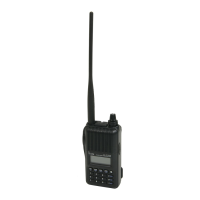New2001
8
3
BATTERY CHARGING
New2001
1
2
3
4
5
6
7
8
9
10
11
12
13
14
15
16
17
18
19
•
R DANGER! NEVER short terminals (or charging terminals)
of the battery pack. Also, current may flow into nearby metal
objects such as a necklace, so be careful when placing bat-
tery packs (or the transceiver) in handbags, etc.
Simply carrying with or placing near metal objects such as
a necklace, etc. may cause shorting. This may damage not
only the battery pack, but also the transceiver.
•R DANGER! NEVER incinerate used battery packs. Inter-
nal battery gas may cause an explosion.
• R DANGER! NEVER immerse the battery pack in water.
If the battery pack becomes wet, be sure to wipe it dry BE-
FORE attaching it to the transceiver.
•CAUTION: Always use the battery within the specified tem-
perature range, –5˚C to +60˚C (+23˚F to +140˚F). Using
the battery out of its specified temperature range will re-
duce the battery’s performance and battery life.
•CAUTION: Shorter battery life could occur if the battery is
left completely discharged, or in an excessive temperature
environment (above +55˚C; +131˚F) for an extended period
of time. If the battery must be left unused for a long time,
it must be detached from the radio after charging. Keep it
safely in a cool dry place at the following temperature range:
–20˚C to +45˚C (–4˚F to +113˚F) (up to a month)
–20˚C to +35˚C (–4˚F to +95˚F) (up to six months)
–20˚C to +25˚C (–4˚F to +77˚F) (up to a year*)
* We recommend charging the battery pack every 6 months.
•Clean the battery terminals to avoid rust or misscontact.
• Keep battery terminals clean. It’s a good idea to clean bat-
tery terminals once a week.
•If your Ni-MH battery pack seems to have no capacity, even
after being charged, completely discharge it by leaving the
power ON overnight. Then, fully charge the battery pack again.
If the battery pack still does not retain a charge (or only very lit-
tle charge), a new battery pack must be purchased.
Prior to using the transceiver for the first time, the battery
pack must be fully charged for optimum life and operation.
•Recommendedtemperaturerangeforcharging:
between 0°C and +45°C for the regular charge by the
transceiver.
or between +10°C and +40°C for the rapid charge with the
BP-191.
•Usethesuppliedcharger(BC-167S)oroptionalcharger
(BC-191) only. NEVER use other manufacturers’ chargers.
•Thebatterypackcontainsarechargeablebattery.
Charge the battery pack before first operating the trans-
ceiver, or when the battery pack becomes exhausted.
If you want to prolong the battery life, the following points
should be observed:
- Avoid over charging.
- Use the battery pack until it becomes almost completely
exhausted, under normal conditions. We recommend bat-
tery charging after transmitting becomes impossible.
■ Caution (for the supplied BP-264 Ni-MH battery pack)

